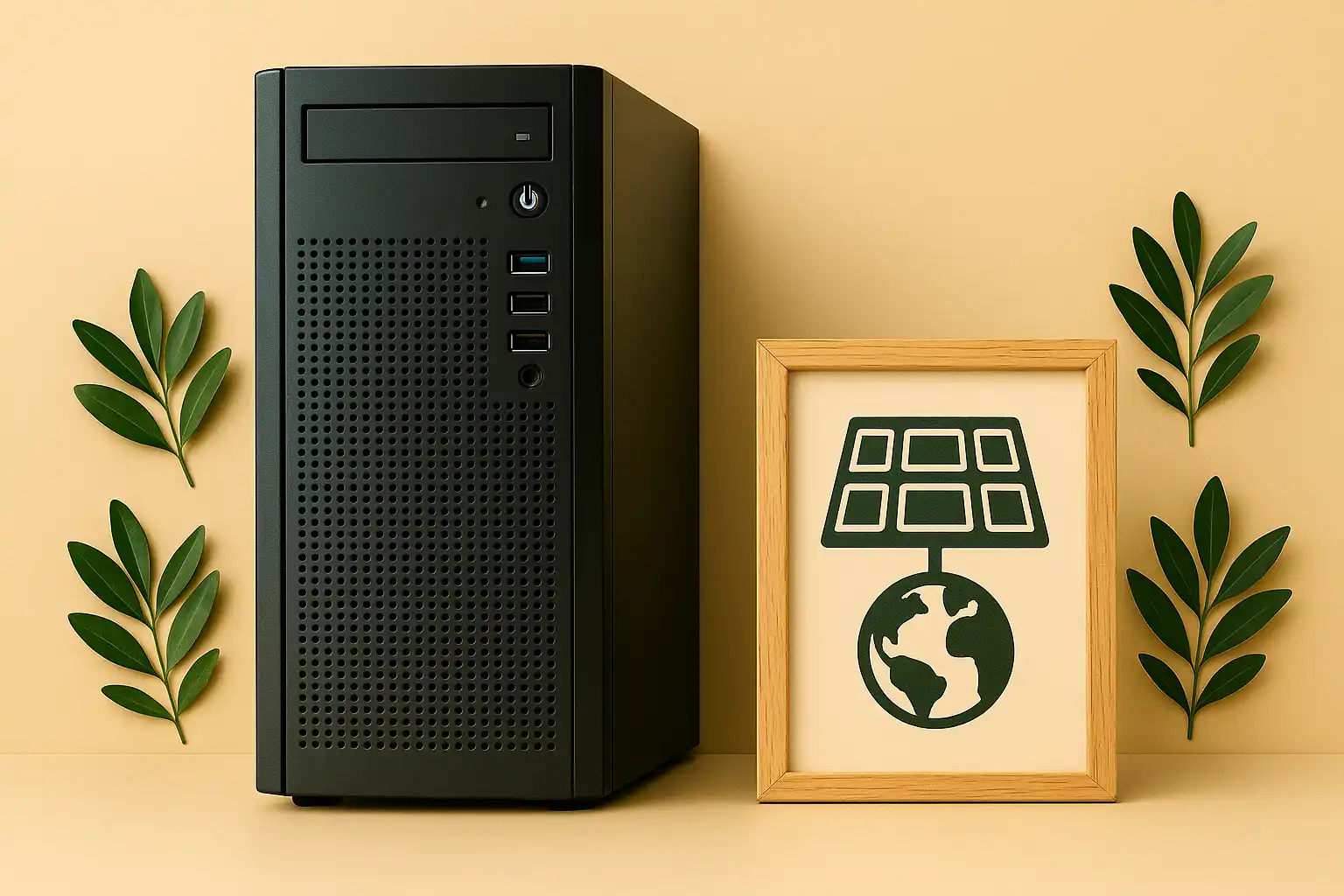Powering the Web, Sustainably: Understanding Energy-Intensive Servers and Green Alternatives

The internet has become the invisible backbone of our modern existence, a ubiquitous utility that underpins nearly every facet of our lives. We communicate, learn, conduct business, and entertain ourselves through a seemingly endless array of online platforms and services. This seamless digital experience, however, belies a significant and rapidly expanding physical infrastructure: vast networks of servers housed within colossal data centers scattered across the globe. These digital powerhouses, the unsung heroes of our connected world, operate tirelessly around the clock, processing and delivering the torrent of information that flows through the internet's arteries.
While the convenience and capabilities afforded by this intricate system are undeniable, the environmental cost of powering and maintaining it is becoming an increasingly pressing concern. Energy-intensive servers, the very core of this infrastructure, are voracious consumers of electricity. Their continuous operation, coupled with the immense processing power required to handle global internet traffic and the necessity for sophisticated cooling systems to prevent overheating, contributes substantially to our collective carbon footprint. As our reliance on digital services continues to grow exponentially, understanding this energy demand and actively seeking sustainable alternatives is no longer a niche concern but a fundamental imperative for a greener future.
The Insatiable Appetite: Why Internet Servers Devour Energy
The sheer scale of the internet's infrastructure is staggering. Millions upon millions of servers, each drawing a significant amount of power, are housed in data centers that can rival small towns in their energy consumption. These facilities, often operating with limited public visibility, are among the fastest-growing electricity consumers worldwide. The energy used to power these servers and keep them at optimal operating temperatures often comes from traditional fossil fuel sources, directly contributing to greenhouse gas emissions and exacerbating the climate crisis.
The lifecycle of a server further compounds the environmental impact. From the energy-intensive manufacturing of its components, including rare earth minerals, to its eventual disposal as electronic waste, each server carries a significant environmental burden. The short lifespan of many servers, driven by technological advancements and the relentless demand for greater processing power, only amplifies this issue.
Recognizing this substantial environmental footprint is the crucial first step towards fostering a more sustainable digital ecosystem. Just as we are increasingly mindful of the energy consumption of our homes, transportation, and everyday products, we must also extend this awareness to the digital realm that has become so deeply integrated into our lives. The good news is that a growing movement within the technology sector is responding to this challenge, pioneering innovative and conscious solutions aimed at decoupling the internet's growth from unsustainable energy practices.
The Green Horizon: Promising Alternatives for a Sustainable Web
Among the most promising alternatives to energy-intensive servers are the adoption of green cloud hosting, the proliferation of data centers powered by renewable energy, and the implementation of intelligent carbon-aware scheduling. These approaches offer tangible pathways to significantly reduce the environmental impact of our digital infrastructure and pave the way for a more sustainable web.
Green Cloud Hosting: A Conscious Choice for Your Digital Presence
For individuals, businesses, and organizations hosting websites, applications, and online services, the choice of hosting provider can have a direct and measurable impact on their digital carbon footprint. Green cloud hosting providers are at the forefront of this sustainable shift, actively working to minimize the environmental cost of their server operations through a variety of strategies.
At the core of green hosting is a commitment to powering data centers with 100% renewable energy sources. This often involves direct procurement of clean energy, such as solar, wind, and hydropower, or the purchase of renewable energy certificates (RECs) that ensure an equivalent amount of renewable energy is fed into the grid to match their consumption. By directly supporting renewable energy infrastructure, green hosting providers reduce their reliance on fossil fuels and the associated greenhouse gas emissions.
Beyond their energy sourcing, green hosting companies also prioritize energy-efficient infrastructure. This includes investing in the latest server hardware designed for optimal power usage, implementing advanced cooling systems that minimize electricity consumption, optimizing airflow within data centers, and employing intelligent power management strategies that dynamically allocate resources based on demand.
While the primary focus is on reducing energy consumption and utilizing renewable sources, some green hosting providers may also engage in carbon offsetting projects to neutralize any remaining emissions. These projects can include reforestation initiatives or investments in other renewable energy projects. However, the most impactful green hosting solutions prioritize direct renewable energy use and energy efficiency measures.
Choosing a green cloud hosting provider for your website or online applications is a direct way to reduce the carbon footprint associated with your digital presence. By supporting these environmentally conscious businesses, you contribute to the growing demand for sustainable internet infrastructure. Brands like GreenGeeks, A2 Hosting, and Krystal are examples of companies offering such services. Investigating their specific renewable energy commitments and energy efficiency practices can help you make an informed decision. Many provide detailed information on their websites regarding their sustainability initiatives.
The transition to green hosting also encourages a greater awareness within the web development and online business communities about the environmental impact of their digital operations. It prompts a shift towards valuing sustainability alongside performance and cost-effectiveness. As the demand for green hosting grows, the industry is likely to see further innovation and the development of even more environmentally friendly solutions.
The adoption of green cloud hosting is not just a technical decision; it's a statement about values. By choosing to host your digital presence with a provider committed to sustainability, you are aligning your online activities with a broader movement towards environmental responsibility. This conscious choice contributes to a greener internet and sends a positive signal to the industry, encouraging others to follow suit.
Data Centers with Renewable Energy: Powering the Core with Clean Sources
Beyond individual hosting providers, the broader trend of data centers transitioning to renewable energy sources is gaining momentum. Major tech companies and data center operators are increasingly committing to powering their massive facilities with solar, wind, and other clean energy sources. These commitments, often driven by corporate sustainability goals and growing consumer demand for environmentally responsible services, represent a potentially transformative shift in the energy landscape of the internet infrastructure.
As these large players transition to solar, wind, and other clean energy sources, the overall carbon footprint of the internet has the potential for substantial reduction. This large-scale demand for renewable energy can also drive further investment and development in the clean energy sector, creating a positive feedback loop that benefits the entire energy grid. The commitment of major corporations to 100% renewable energy targets often includes their data center operations, recognizing the significant energy consumption involved. This shift not only reduces direct emissions from the data centers but also sends a powerful signal to energy providers and policymakers about the viability and importance of clean energy solutions.
Carbon-Aware Scheduling: Intelligent Energy Optimization
An innovative approach to reducing the carbon footprint of data centers involves "carbon-aware scheduling." This intelligent system leverages real-time data on the carbon intensity of the electricity grid to dynamically manage computational workloads and energy consumption within data centers.
The fundamental principle is to shift non-critical tasks and energy usage to times when the electricity grid is powered by cleaner sources, such as during peak solar or wind generation periods. By intelligently aligning energy demand with the availability of renewable energy, carbon-aware scheduling can significantly reduce reliance on fossil fuel-based electricity, effectively lowering emissions without necessarily requiring immediate and complete infrastructure overhauls. This approach offers a flexible and dynamic way to optimize energy consumption and integrate renewable energy more seamlessly into the operation of data centers. Research and development in this area are ongoing, with the potential for significant advancements in the coming years. As grid infrastructure becomes smarter and more granular data on energy sources becomes available, carbon-aware scheduling will likely become an increasingly important tool for sustainable web operations.
Empowering a Greener Web: Making Conscious Choices
While the intricacies of internet infrastructure might seem abstract, the choices we make as individuals and businesses can collectively influence the demand for more sustainable solutions. By choosing green hosting, demanding transparency, optimizing digital consumption, and supporting sustainable tech initiatives, we can collectively work towards a greener web, powering the digital world in a way that is both innovative and kind to our planet. The responsibility for a sustainable internet lies not just with the large corporations that build and maintain the infrastructure, but also with the individuals and organizations that utilize it. By making conscious choices about our digital footprint, we can contribute to a future where the power of the web is harnessed in harmony with the needs of our environment.
Related Blogs

Neutralizing Your Tech Footprint: Choosing Carbon-Neutral Tech Purchases
Support climate action by opting for carbon-neutral certified tech and offset programs.

The Silent Energy Thief: Cutting Down Idle Device Usage for a Sustainable Digital Footprint
Improve energy efficiency and extend device life by implementing power-saving settings.

The Unseen Gigabytes: Cutting Your Streaming Carbon Footprint
Reduce your digital carbon footprint by adjusting streaming quality and habits.

Swipe Right on Sustainability: How Digital Decluttering Cultivates a Greener Lifestyle
Insights on digital decluttering for a greener lifestyle in a sustainable way.

Decoding Disposal: Your Essential Guide to Responsibly Recycling E-Waste
Insights on the rise of ethical tech in a sustainable way.

Surfing Sustainably: Unveiling the World of Eco-Friendly Browsing
Insights on eco-friendly browsing in a sustainable way.
Stay in the Loop
Get tips and insights tailored to your interests — no spam, just sustainability.